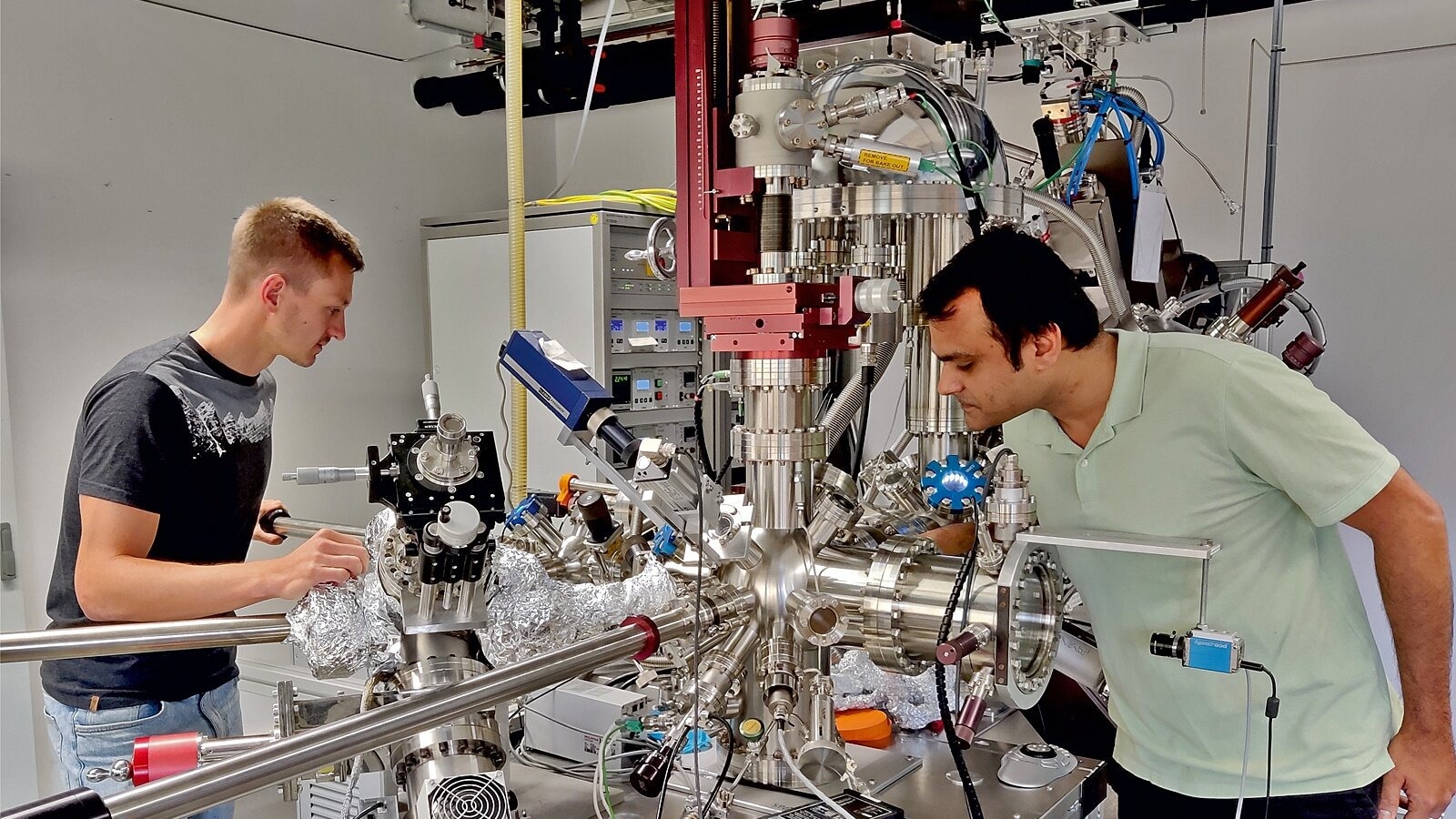As part of the research group “Proximity-induced correlation effects in low-dimensional structures (FOR 5242),” scientists from Chemnitz University of Technology’s Professorship of Analysis of Solid Surfaces and Professorship of Experimental Physics with a particular emphasis on Technical Physics are investigating the functionalization of low-dimensional electron gases.
 Chritran Ghosal (r.) and Dr Philip Schädlich examine the electronic properties of the 2D meat layers in a laboratory at the TUC’s Institute of Physics. Image Credit: Franziska Schölzel
Chritran Ghosal (r.) and Dr Philip Schädlich examine the electronic properties of the 2D meat layers in a laboratory at the TUC’s Institute of Physics. Image Credit: Franziska Schölzel
The research team led by first author Dr. Philip Schädlich, a research associate at the Professorship of Experimental Physics with a focus on Technical Physics, recently published their findings in the prestigious journal Advanced Materials Interfaces.
They described a method for the first detailed structural analysis of synthesized two-dimensional lead layers on a specially designed system.
The method that has been laid out has also made it feasible to create samples that are of high enough quality to completely clarify the structures. The unique electronic system development and the creation of quantum materials for quantum computing could benefit from the fresh understandings gained from fundamental research.
Our synthesis, together with a meticulous data analysis by the various groups, has now achieved this comprehensive picture of the two-dimensional lead layers.
Philip Schädlich, Research Assistant, Chemnitz University of Technology
Prof. Dr. Thomas Seyller, who is from Chemnitz University of Technology, further stated, “The controlled coupling of functionalized graphene to 2D electron gases opens up the possibility to investigate and control correlation effects and mesoscopic phenomena in 2D materials - for example superconductivity, spin or charge density waves and novel magnetic phases.”
The German Research Foundation (DFG) funds the researchers who collaborate across disciplines and regions to study these types of systems. Participants included partners from Jülich, Lund (Sweden), Hamburg, Regensburg, Göttingen, Stuttgart, and Braunschweig.
The high degree of mixing with different professional competencies in our research group is necessary to be able to explore all facets of such complex problems in detail. Only in this way can structural and electronic properties of the self-made systems be linked.
Dr. Christoph Tegenkamp, Professor, Chemnitz University of Technology
Trick of Nature: Domain Boundaries in Response to Unsaturated Bonds
Schädlich further stated, “The structure formation of the 2D lead layer is based on motifs that we know from previous experiments on the adsorption of lead on silicon surfaces.”
The phrase “devil’s staircase” has been coined to describe the phase diagram’s extreme diversity caused by the flexibility of the lead bonds.
In contrast, in the current experiment, the lattice mismatch between the substrate and the lead layer results in a shortage of lead atoms per silicon atom of the substrate, resulting in strains in the lead and unsaturated bonds on the substrate surface.
Researchers now understand why this is so:
“It is a trick of nature. The lead layer forms domains in which the lead atoms relax locally to their favorite distance and which are small enough so that the total offset between the lead and substrate lattice is not too large,” Schädlich further added.
Chitran Ghosal, a doctoral student in Prof. Tegenkamp’s working group, stated, “To do this, the centers of neighboring domains have to be slightly offset against each other, so that the resulting boundaries of the domains just contain enough lead atoms to automatically also compensate all unsaturated bonds.”
Great Importance of Domain Boundaries
Graphene is affected by the lead layer’s structure as well since the data analysis revealed a charge carrier concentration that was vanishingly low and approximately 1000 times lower than that of epitaxial graphene.
Ghosal further added, “Unlike significantly more efficient intercalants such as hydrogen, the lead layer also manages to shield or compensate the spontaneous polarization of the substrate and thus provide for quasi-charge neutrality.”
Additionally, the fingerprint of a so-called Kekulé ground state was discovered using scanning tunneling microscopy at low temperatures of four Kelvin (about –269 degrees Celsius). The domain borders are crucial in this situation as well since the electrons distributed on them have a constrained phase space owing to charge neutrality.
Background: DFG Research Group “Proximity-induced correlation effects in low-dimensional structures” Led by Chemnitz University of Technology
The DFG research team headed by Prof. Tegenkamp is focused on phenomena like the one being presented right now. The research team, which has received funding of EUR 4,000,000, has committed itself to examining correlation effects in 2D materials and bringing together the skills of eight working groups from around Germany.
The objective is to precisely control 2D materials and study unusual phenomena, including superconductivity, charge density waves, Mott states, quantum Hall effect, and Klein tunneling.
Journal Reference:
Schädlich, P., et al. (2023) Domain Boundary Formation Within an Intercalated Pb Monolayer Featuring Charge-Neutral Epitaxial Graphene. Advanced Materials Interfaces. doi:10.1002/admi.202300471.